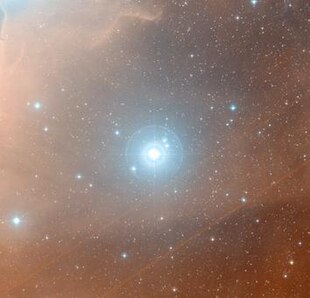Sigma Orionis
|
Multiple star σ Orionis |
|||||||||||||||||||
|---|---|---|---|---|---|---|---|---|---|---|---|---|---|---|---|---|---|---|---|

|
|||||||||||||||||||
| DSS image | |||||||||||||||||||
| AladinLite | |||||||||||||||||||
|
Observation dates equinox : J2000.0 , epoch : J2000.0 |
|||||||||||||||||||
| Constellation | Orion | ||||||||||||||||||
| Right ascension | 05 h 38 m 44.8 s | ||||||||||||||||||
| declination | -2 ° 36 ′ 0 ″ | ||||||||||||||||||
| Apparent brightness | A: 4.2 likes B: 5.1 likes C: 8.79 likes D: 6.62 likes E: 6.66 likes |
||||||||||||||||||
| Typing | |||||||||||||||||||
| B − V color index |
A :? B :? C: −0.02 D: −0.20 E: −0.18 |
||||||||||||||||||
| U − B color index |
A :? B :? C: -0.25 D: -0.87 E: -0.86 |
||||||||||||||||||
| Spectral class | A: O9V B: B0.5V C: A2V D: B2V E: B2Vp |
||||||||||||||||||
| Variable star type | Component E | ||||||||||||||||||
| Astrometry | |||||||||||||||||||
| distance | ≈ 1060 ly | ||||||||||||||||||
| Physical Properties | |||||||||||||||||||
|
Other names and catalog entries |
|||||||||||||||||||
|
|||||||||||||||||||
Sigma Orionis ( σ Orionis , short σ Ori ) is a system of five stars in the constellation Orion, about 1060 light years away . The core is a spectroscopic double star with magnitudes 4.2 and 5.1 mag, the sum of which is 3.8 mag. The star group is part of the eponymous Sigma-Orionis cluster .
Star system
In the center of Sigma Orionis lies a stable binary star system with Sigma Orionis A and Sigma Orionis B , around which the three outer stars Sigma Orionis C , Sigma Orionis D and Sigma Orionis E move on irregular orbits . A and B are only 0.25 arcsecond apart and can therefore hardly be separated even in large telescopes.